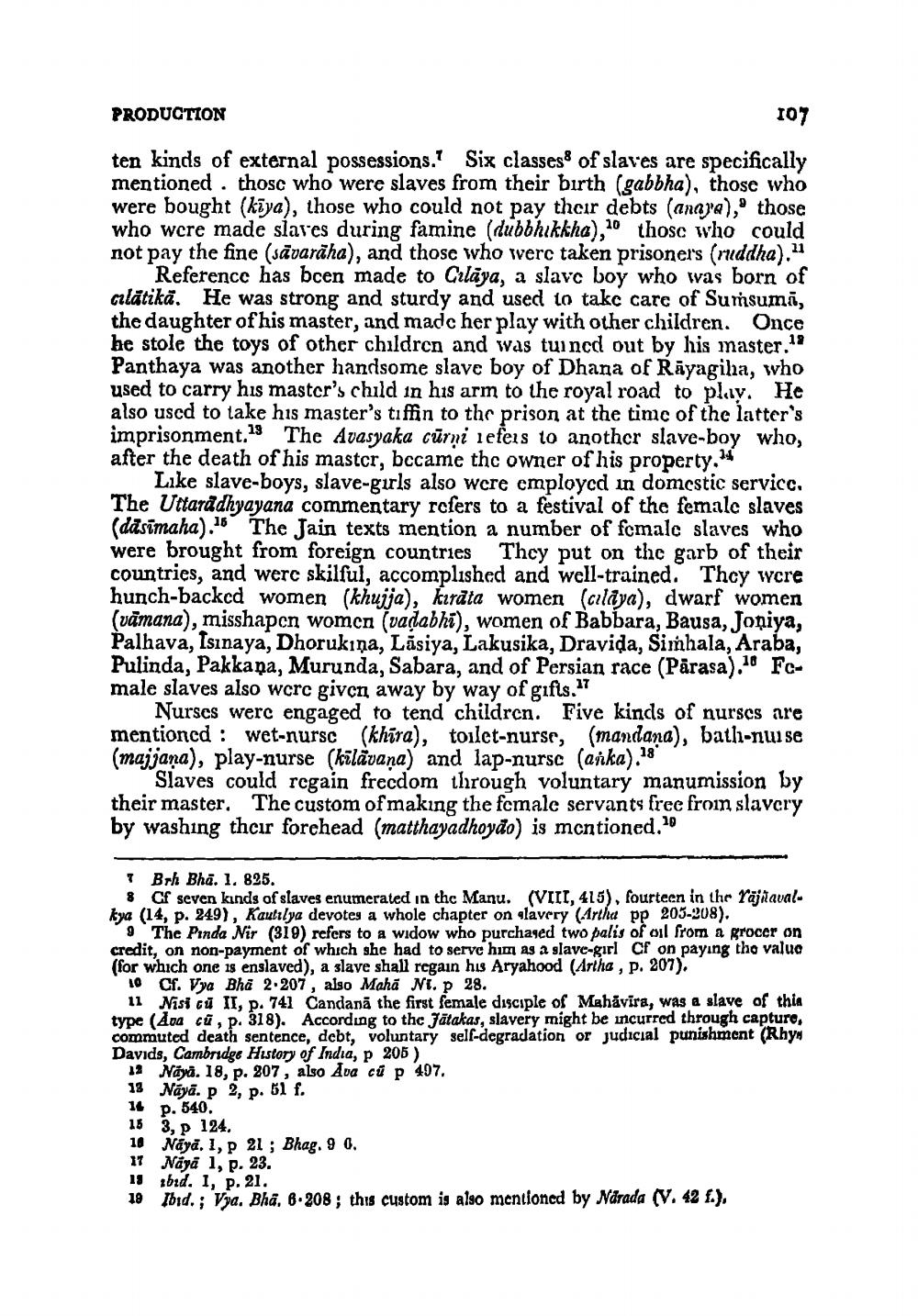________________
PRODUCTION
107
ten kinds of external possessions." Six classes of slaves are specifically mentioned . thosc who were slaves from their birth (gabbha), those who were bought (kīya), those who could not pay their debts (anaya),' those who were made slaves during famine (dubbhikkha), 10 those who could not pay the fine (sävarāha), and those who were taken prisoners (ruddha).11
Reference has bcen made to Crlaya, a slave boy who was born of cilātikā. He was strong and sturdy and used to take care of Sumsumā, the daughter of his master, and made her play with other children. Once he stole the toys of other children and was tuined out by his master.19 Panthaya was another handsome slave boy of Dhana of Rāyagiha, who used to carry his master's child in his arm to the royal road to play. He also used to take his master's tiffin to the prison at the timc of the latter's imprisonment.19 The Avasyaka cūrni refers to another slave-boy who, after the death of his master, became thc owner of his property.14
Like slave-boys, slave-girls also were employed in domestic servicc. The Uttaradhyayana commentary refers to a festival of the female slaves (dasimaha).16 The Jain texts mention a number of female slaves who were brought from foreign countries They put on the garb of their countries, and werc skilful, accomplished and well-trained. Thcy were hunch-backed women (khujja), kiráta women (alaya), dwarf women (vāmana), misshapen women (vadabhi), women of Babbara, Bausa, Joniya, Palhava, Isinaya, Dhorukina, Lāsiya, Lakusika, Dravida, Simhala, Araba, Pulinda, Pakkana, Murunda, Sabara, and of Persian race (Pārasa). Fcmale slaves also were given away by way of gifts."
Nurses were engaged to tend children. Five kinds of nurses are mentioncd : wet-nursc (khira), toilet-nurse, (mandana), bathi-nu se (majjana), play-nurse (kilăvana) and lap-nursc (anka).18*
Slaves could regain frecdom through voluntary manumission by their master. The custom of making the female servants free froin slavery by washing their forehead (matthayadhoyão) is mentioned."
I Brh Bha. 1. 825.
8 Cf seven kinds of slaves enumerated in the Manu. (VIII, 415), fourteen in the rajnaval. kya (14, p. 249), Kautilya devotes a whole chapter on alavery (Artha pp 205-208).
9 The Pinda Nir (319) refers to a widow who purchaged two palis of oil from a grocer on credit, on non-payment of which she had to serve him as a slave-girl Cf on payıng the value (for which one is enslaved), a slave shall regain his Aryahood (Artha, p. 207),
10 Cf. Vya Bha 2.207, also Mahā Ni. p 28.
11 Nisi cu II, p. 741 Candan, the first female disciple of Mahavira, was a slave of this type (Ava cū, p. 318). According to the Fatakas, slavery might be incurred through capture, commuted death sentence, debt, voluntary self-degradation or judicial punishment (Rhy Davids, Cambridge History of India, P 205 )
13 Naya. 18, p. 207, also Ava cú p 497. 13 Naya. p 2, p. 51 f. 14 P. 540. 15 3, 124. 18 Naya. 1, p 21 ; Bhag. 9 0. 17 Nága 1, p. 23. 13 zbid. I, p. 21. 19 Ibid. ; Vya. Bha, 8.208; this custom is also mentioned by Ndrada (V. 42 f.),




